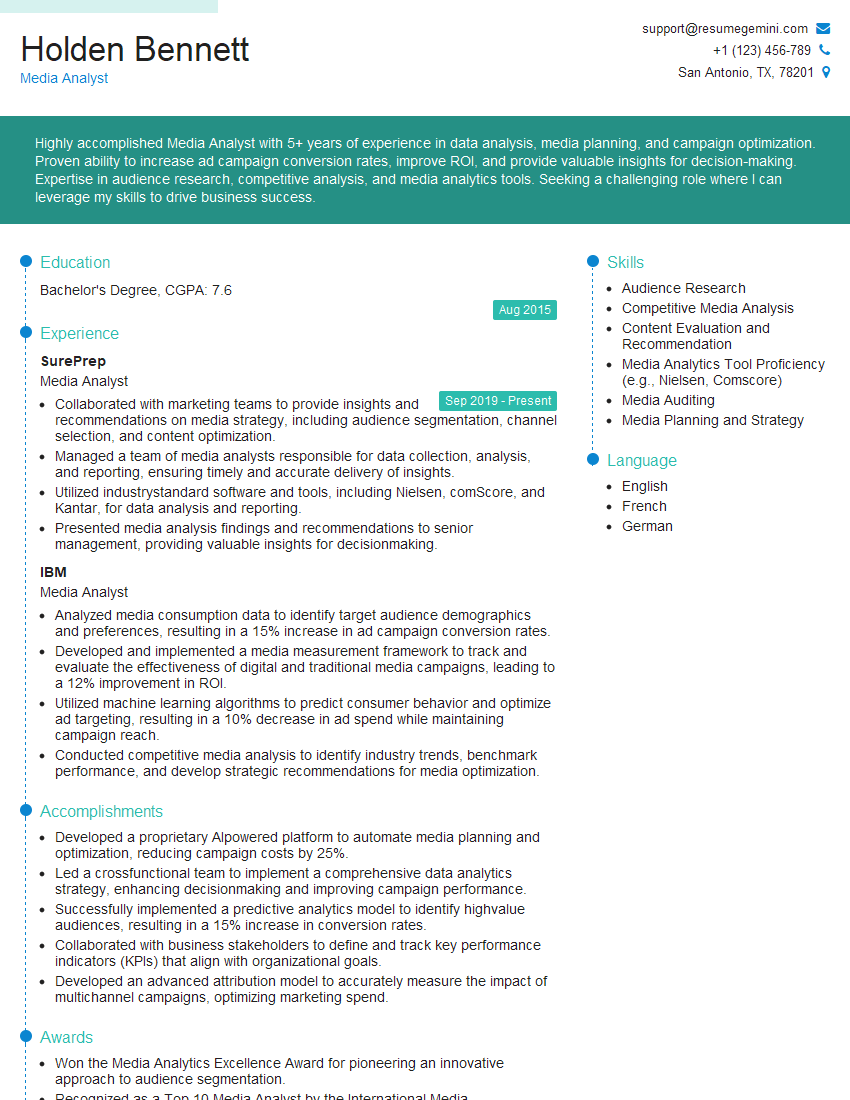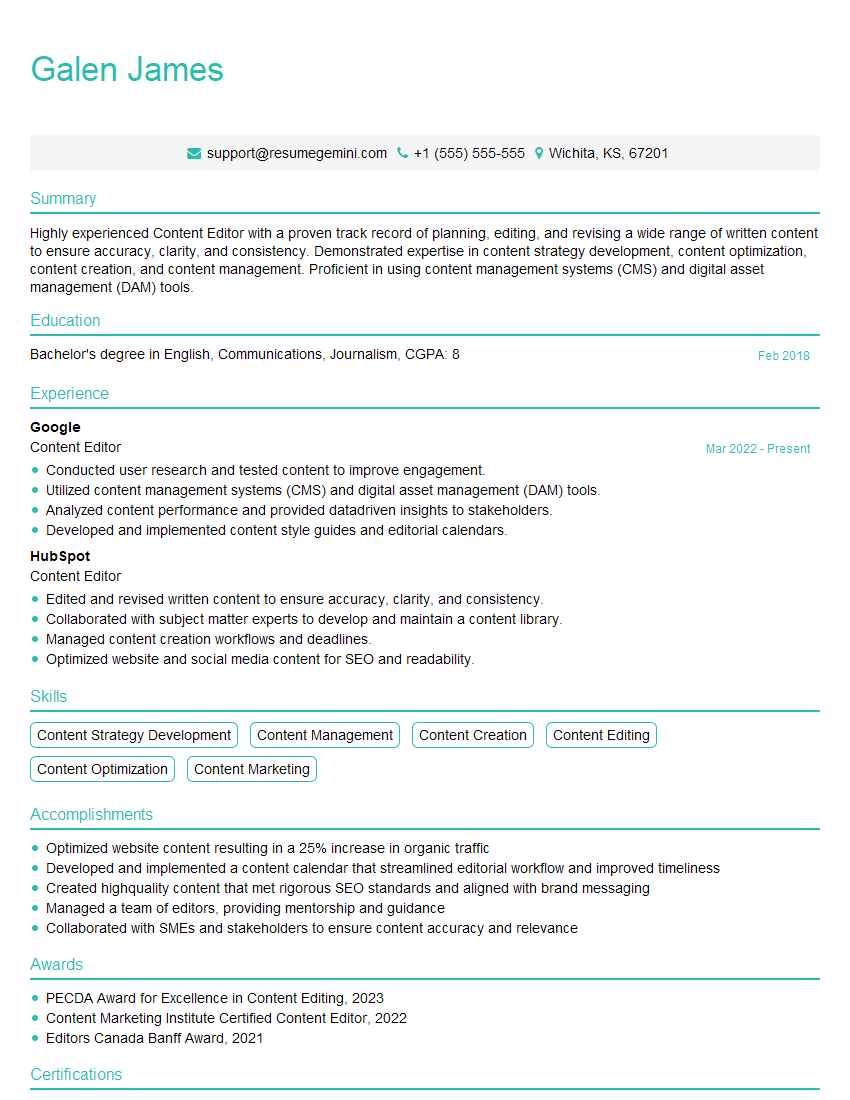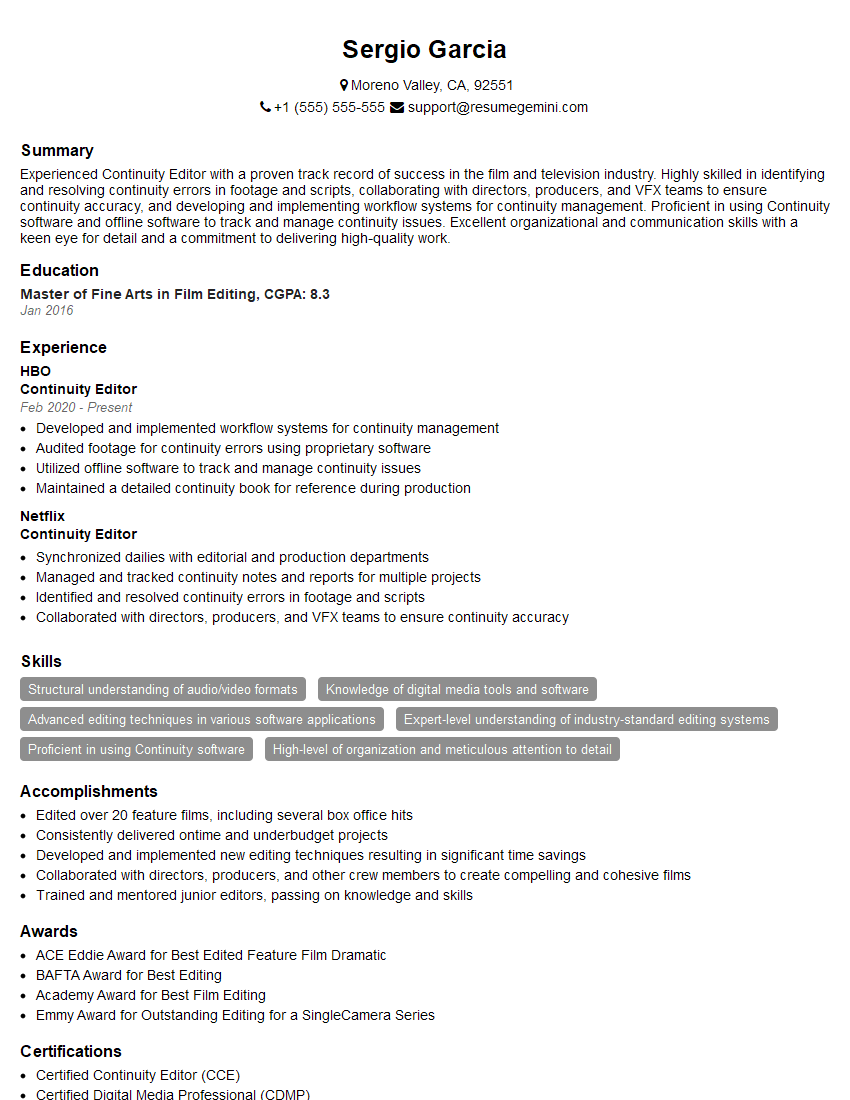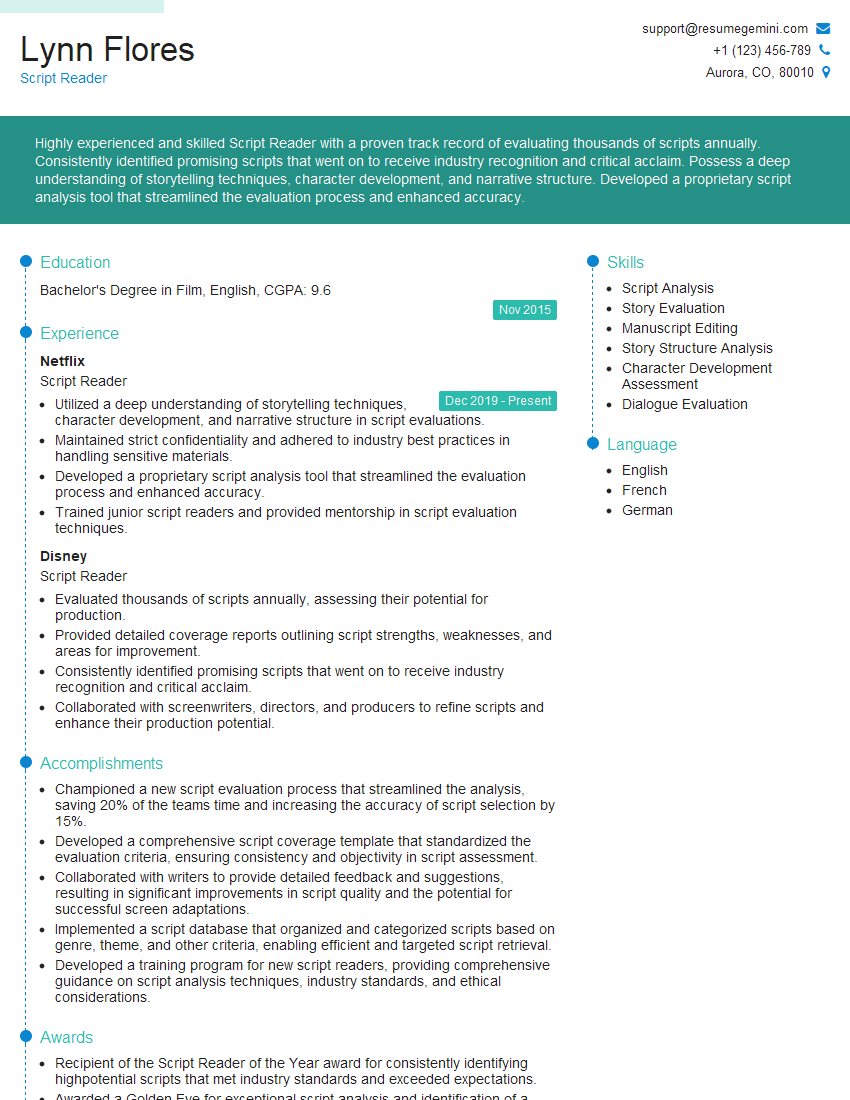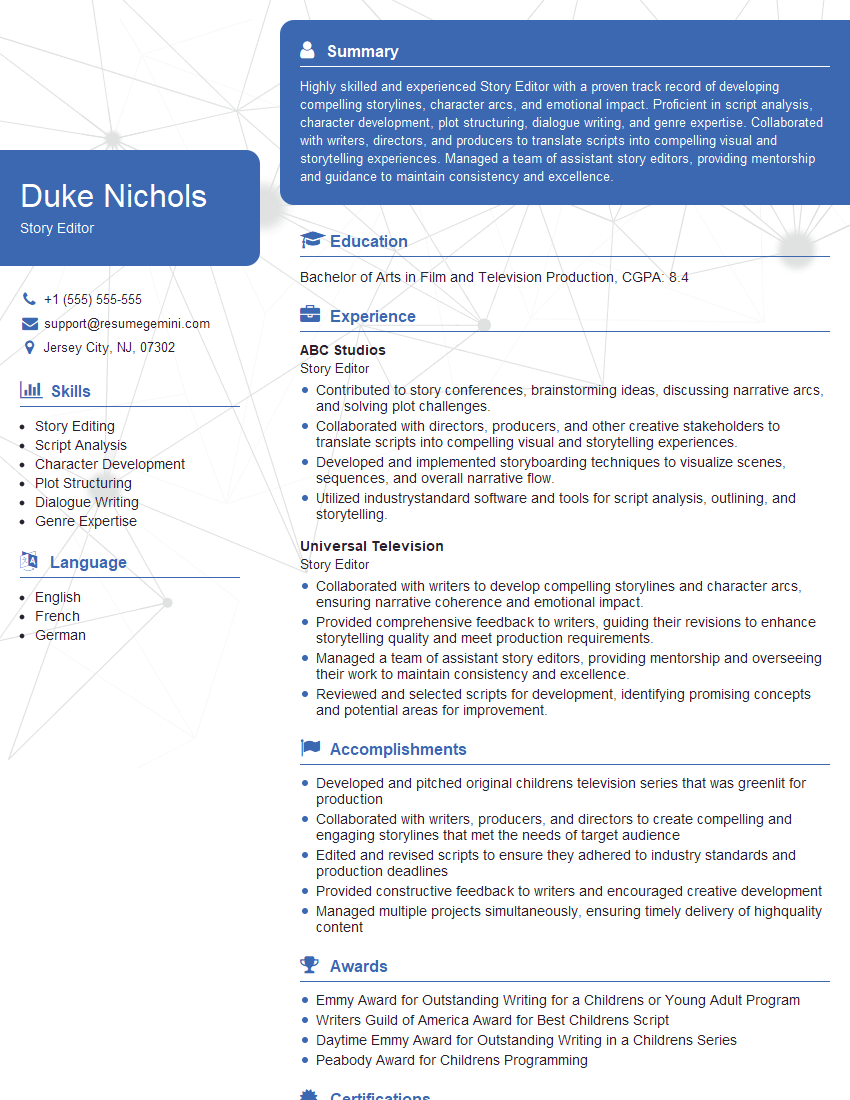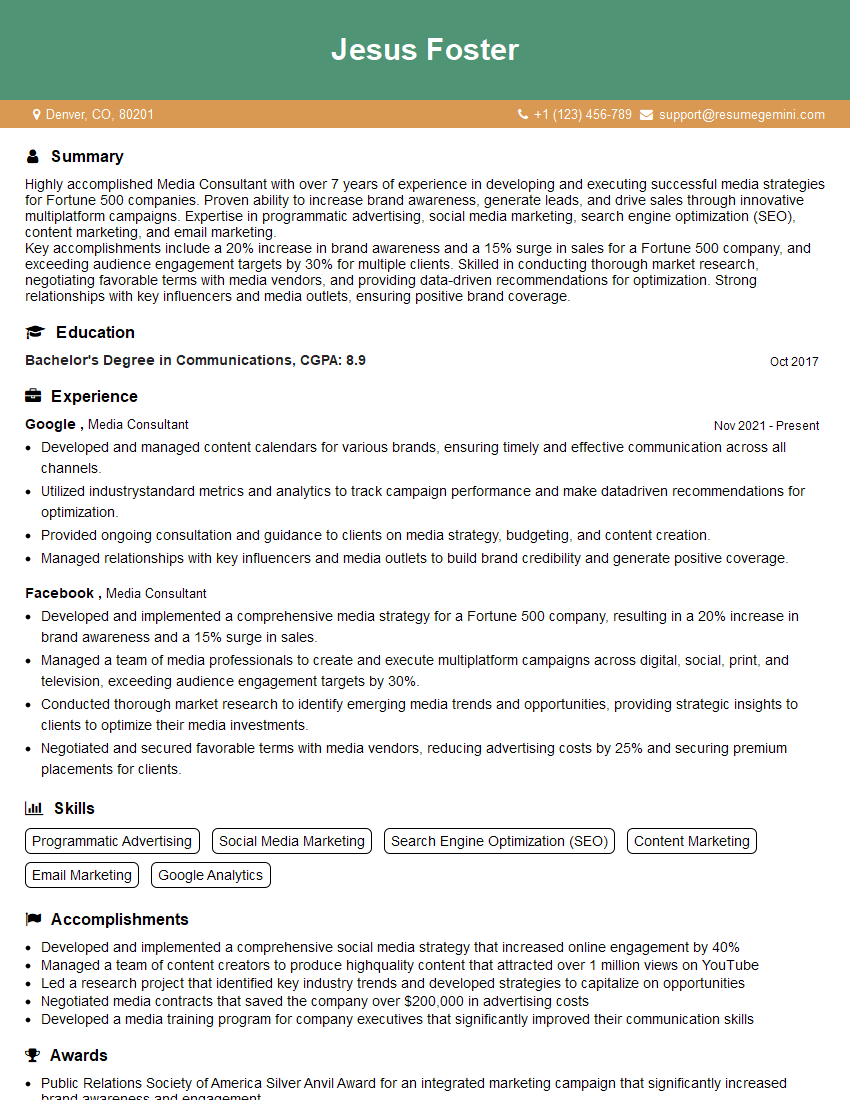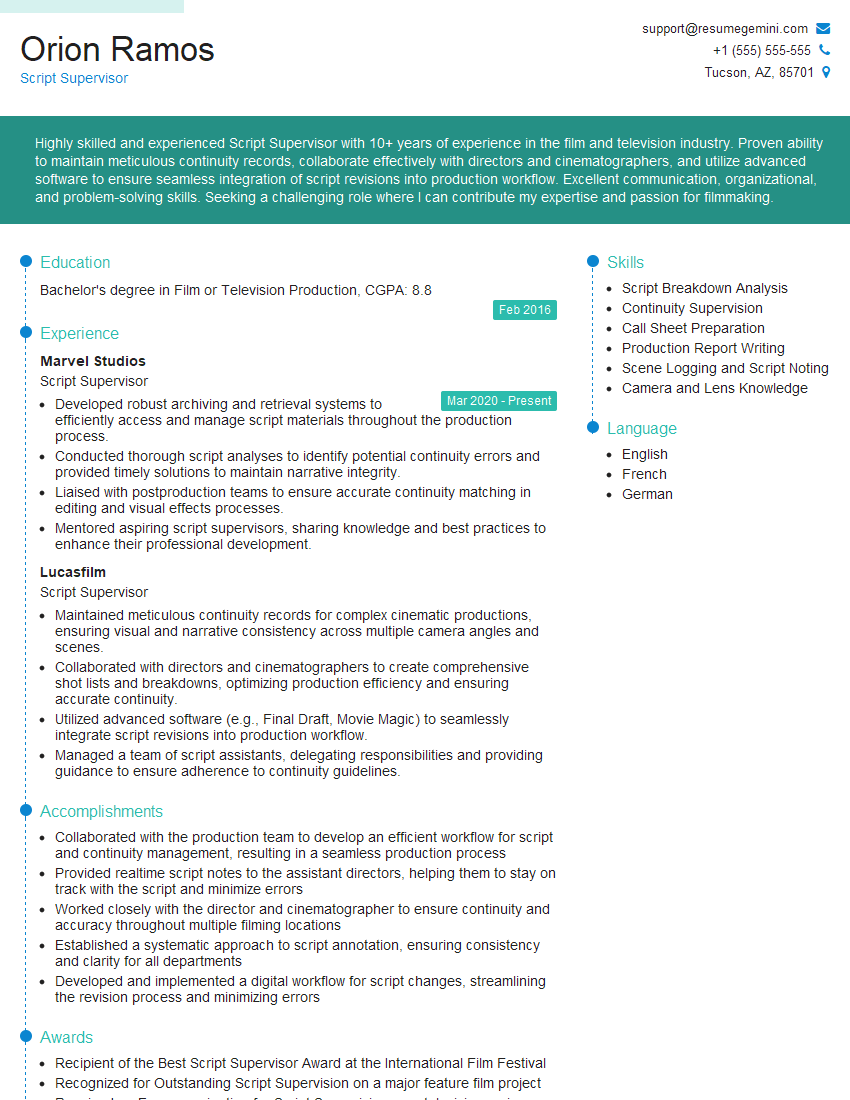Interviews are opportunities to demonstrate your expertise, and this guide is here to help you shine. Explore the essential Script Analysis and Adaptation interview questions that employers frequently ask, paired with strategies for crafting responses that set you apart from the competition.
Questions Asked in Script Analysis and Adaptation Interview
Q 1. Explain your process for analyzing a screenplay’s structure.
Analyzing a screenplay’s structure involves dissecting its narrative architecture to understand how the story unfolds. I typically begin by identifying the core elements: the inciting incident, plot points, rising action, climax, falling action, and resolution. I then examine how these elements are sequenced and interconnected. This often involves creating a beat sheet – a scene-by-scene breakdown outlining the key events and their dramatic function. This helps visualize the narrative’s progression and reveals any structural weaknesses. For example, a poorly placed plot point might disrupt the pacing or a weak climax could leave the audience unsatisfied. Beyond the classic three-act structure, I also consider variations like the Hero’s Journey or other narrative structures, analyzing how effectively the script employs them. Finally, I consider the overall shape of the story’s arc, noting whether it feels satisfying and logically constructed.
Imagine analyzing a thriller. A beat sheet might reveal that the inciting incident is weak, delaying the introduction of the central conflict. Or perhaps the rising action feels rushed, lacking sufficient build-up to the climax. By meticulously examining the screenplay’s structural components, I can identify such imbalances and suggest improvements.
Q 2. How do you identify plot holes or inconsistencies in a script?
Identifying plot holes and inconsistencies is crucial for ensuring narrative coherence. My process involves a careful, sequential reading of the script, paying close attention to details across the entire narrative. I check for inconsistencies in character behavior, motivations, and backstories. I also meticulously trace the causal chain of events, looking for any gaps or illogical leaps. For example, a character’s sudden change in personality without a clear explanation is a red flag. Similarly, a crucial piece of information introduced late in the story that should have impacted earlier events indicates a plot hole. I often utilize a character chart and timeline to track these elements, visually representing potential inconsistencies.
Consider a detective story where a crucial piece of evidence is found in the final act, but this evidence could have easily been discovered earlier, influencing the investigation’s course. That’s a clear plot hole. By meticulously tracking characters, plot points, and timelines, I can pinpoint such inconsistencies and propose solutions, ensuring that the narrative remains believable and engaging.
Q 3. Describe your approach to adapting a novel or short story for the screen.
Adapting a novel or short story for the screen is a transformative process. It requires distilling the essence of the source material while acknowledging the fundamental differences between the two mediums. My approach begins with a thorough reading of the source text, focusing on identifying the core themes, conflicts, and characters. I then develop a treatment, a concise outline of the screenplay, which focuses on visual storytelling. This stage involves deciding what aspects of the novel will be retained, which will be condensed, and which will be omitted altogether. It’s about choosing the most impactful scenes and structuring them for maximum dramatic effect on screen. I prioritize visual storytelling, understanding that film relies on imagery and action far more than written descriptions. Character development must be adapted accordingly, showing rather than telling. Often, I will consolidate multiple characters into one or conversely break down a single character into multiple roles to better fit the screen format.
Adapting a novel like ‘The Lord of the Rings’ into a film trilogy requires extensive choices about which plot lines to prioritize and condense. Many subplots and characters are necessarily omitted or significantly altered to create a cohesive, engaging cinematic experience that maintains the essence of the original material within a limited timeframe.
Q 4. What are the key differences between adapting a novel and a stage play?
Adapting a novel differs significantly from adapting a stage play. Novels offer vast narrative scope and internal monologues, while stage plays are inherently more concise and dialogue-driven. Adapting a novel requires significant condensation and focus on visual storytelling, often discarding subplots or inner thoughts to maintain a cinematic pace. Stage plays, on the other hand, often translate more directly to the screen, requiring adjustments primarily in visual staging and camera angles. However, both require an understanding of character arcs, thematic concerns and dramatic structure to create a successful screen adaptation.
Think of a play like ‘Hamlet’. Much of its power lies in its dialogue and character interactions. Adapting it for the screen might involve expanding certain scenes visually, adding external action, or refining existing dialogue for the camera. Conversely, adapting a sprawling novel like ‘War and Peace’ requires a significant restructuring and prioritization of events to fit the cinematic format.
Q 5. How do you handle conflicting narrative voices in a script?
Conflicting narrative voices can enrich a story, but they require careful management. My approach involves analyzing the purpose and perspective of each voice, understanding how they contribute to the overall narrative. I determine if the conflicts are integral to the plot or merely stylistic choices. If the conflicts hinder clarity, I may choose to prioritize one voice, weaving elements from other voices subtly to enhance the primary narrative. Alternatively, I might use cinematic techniques – such as parallel editing or voiceovers – to present different viewpoints simultaneously, creating a multi-layered narrative experience. This requires a nuanced understanding of the source material and how to translate conflicting viewpoints into a cohesive and comprehensible whole.
For example, a script might feature a first-person narration that clashes with the objective reality presented through other characters’ actions. By careful restructuring and editing, I can unify the narrative, ensuring that the conflicting voices enhance the story rather than detracting from it.
Q 6. Explain how you would assess the pacing of a screenplay.
Assessing a screenplay’s pacing requires evaluating the rhythm and flow of the narrative. I analyze the length and impact of scenes, the transitions between them, and the overall distribution of plot points. A well-paced script avoids both dragging and rushing, maintaining audience engagement throughout. I use tools such as beat sheets and scene-by-scene analysis to identify any pacing problems. Slow stretches may necessitate cutting unnecessary scenes or adding conflict to heighten tension. Conversely, fast-paced sections might require additional scenes to allow the audience to breathe and process information. Ultimately, the goal is to create a rhythm that builds suspense, introduces characters and plot points effectively and delivers a satisfying conclusion.
Consider a romantic comedy. A slow-paced sequence might be improved by adding a light comedic element to keep the audience engaged. Alternatively, a section that jumps too quickly between romantic gestures and relationship conflicts could benefit from expanding on certain scenes or adding transitional moments to maintain a smooth and believable flow.
Q 7. How do you evaluate the effectiveness of a script’s dialogue?
Evaluating dialogue’s effectiveness focuses on its role in character development, plot advancement, and thematic expression. I assess whether the dialogue is believable, efficient, and reveals character traits. I look for clichés and unnatural speech patterns. Dialogue should be economical, avoiding unnecessary exposition, and instead using subtext and implication to convey meaning. It should also be appropriate to the characters’ backgrounds and relationships. A strong script uses dialogue to showcase character relationships, reveal motivations and advance the plot organically. Ineffective dialogue feels contrived or unnatural, hindering character development and plot progression. Effective dialogue is crisp and impactful.
For example, a character speaking in excessively formal language that is inconsistent with their personality indicates ineffective dialogue. Likewise, dialogue that merely states facts rather than revealing character or advancing the plot needs improvement. Good dialogue reveals character through action and speech.
Q 8. What are your techniques for identifying and improving character development?
Identifying and improving character development is crucial for a compelling narrative. My approach involves a multi-faceted analysis, starting with a deep dive into the character’s backstory, motivations, and relationships. I look for consistency in their actions and dialogue, ensuring their choices align with their established personality traits. I often use character sketches or ‘character Bibles’ to document this information.
For improvement, I analyze scenes where the character feels underdeveloped. Are their motivations clear? Do their actions ring true to their personality? If not, I explore potential conflicts, internal or external, that could drive their narrative arc and reveal more depth. For example, a seemingly passive character might have a hidden strength revealed through a moment of crisis. I might also add scenes to explore their past, revealing formative experiences that shape their present actions. Ultimately, the goal is to create characters that are believable, relatable, and memorable.
- Technique 1: Backstory Deep Dive: Exploring the character’s past, childhood, relationships, and defining experiences.
- Technique 2: Motivational Analysis: Identifying the character’s primary goals, desires, and fears, and how these drive their actions.
- Technique 3: Consistency Check: Ensuring the character’s behavior remains consistent throughout the story, considering their personality and background.
Q 9. Describe your process for providing constructive feedback on a script.
Providing constructive feedback on a script requires a delicate balance of praise and criticism. I start by focusing on the strengths of the script, highlighting what works well – compelling scenes, well-developed characters, engaging dialogue. This creates a positive foundation for the feedback that follows.
Then, I move onto constructive criticism, focusing on specific areas for improvement. I avoid vague statements like ‘it’s boring’ and instead pinpoint specific issues. For example, instead of saying ‘the dialogue is weak,’ I might say ‘the dialogue in Scene 3 feels unnatural, particularly the exchange between characters A and B. Consider revising their lines to reflect their personalities more accurately.’ I also suggest alternative solutions, offering concrete suggestions for improvement rather than simply pointing out flaws. Finally, I always frame my feedback within the context of the script’s goals and target audience.
My process often involves using a structured feedback form to ensure thoroughness and to allow for clear communication. I prioritize clarity and specificity to provide actionable insights.
Q 10. How do you balance creative input with the director’s vision?
Balancing creative input with the director’s vision is essential for a collaborative and successful project. My approach is to understand the director’s overall vision early in the process through detailed discussions and review of any available creative materials. This provides a framework for my contributions. I then use my script analysis expertise to offer creative suggestions that align with, or enhance, that vision. For example, I might suggest alternative scene structures or character interactions that maintain the overall tone and thematic elements while improving pacing or dramatic impact.
It’s crucial to be flexible and adaptable. I understand that my role is to support the director’s artistic goals, not to impose my own. Open communication is paramount; I am always receptive to the director’s feedback and willing to compromise or adjust my suggestions to ensure a shared understanding and a cohesive final product. I view my role as a collaborative partnership, not a battle for creative control.
Q 11. How would you approach adapting a script for a different target audience?
Adapting a script for a different target audience requires a nuanced understanding of the cultural context, language, and sensitivities of the new audience. I start by thoroughly researching the new target audience, identifying their preferences, values, and expectations. This research informs all subsequent adaptation decisions.
Adaptation might involve adjusting the language to reflect the audience’s vernacular, simplifying complex concepts, or altering cultural references to ones that resonate with the new audience. It might also require changing the overall tone or style to suit their preferences. For instance, a script originally aimed at adults might need simplification of language and thematic elements to be suitable for a younger audience. This could involve removing mature themes or changing complex plot points into simpler narratives. Sensitivity to cultural differences is paramount, avoiding stereotypes or potentially offensive content.
Q 12. What are some common challenges you face when adapting a source material?
Adapting source material presents several challenges. One common challenge is balancing faithfulness to the original work with the need for adaptation. Striking the right balance is crucial, ensuring the adaptation captures the essence of the original while making it suitable for its new form and audience.
Another challenge is dealing with rights and permissions. Securing the rights to adapt a specific work can be complex, requiring legal expertise and negotiation. Furthermore, changes to the source material, especially if significant, could require renegotiation or affect the licensing agreement. Finally, adapting works with complex plots or established characters requires careful consideration to ensure continuity and avoid alienating existing fans. This often involves streamlining or condensing certain plot points while adding elements for a richer narrative experience.
Q 13. How do you handle time constraints when adapting a script?
Time constraints are a frequent reality in script adaptation. My approach involves prioritizing key elements of the story and streamlining less essential parts. I create a detailed outline, focusing on the core plot points and character arcs, ensuring a tight narrative structure. This enables me to identify areas where scenes can be shortened or even removed without compromising the story’s integrity.
I employ efficient writing techniques, focusing on concise language and avoiding unnecessary exposition. Collaboration with the director and other team members is crucial for effective time management. Open communication and clear expectations help ensure everyone works towards a common goal within the allocated timeframe. Sometimes, difficult decisions need to be made – sacrificing certain scenes or subplots to meet the deadline, always prioritizing the most vital elements of the story.
Q 14. What are your preferred methods for script analysis software?
While I don’t rely on any single software as my primary tool, I frequently utilize several programs depending on the project’s needs. For example, Final Draft is widely recognized for its screenwriting features, and offers robust revision tracking capabilities which are vital when collaborating on adaptations. I also make use of simpler word processors like Google Docs for collaborative editing.
Beyond script writing software, I use project management tools such as Trello or Asana to manage tasks, deadlines, and collaborative efforts, allowing for streamlined workflow when working on large-scale adaptation projects. My choice of software is always dictated by the specific demands of each project, prioritizing the software’s functionality and collaborative capabilities.
Q 15. Describe your familiarity with various narrative structures (e.g., three-act, Hero’s Journey).
Understanding narrative structure is fundamental to script analysis and adaptation. While many structures exist, two of the most common are the three-act structure and the Hero’s Journey. The three-act structure divides a story into Setup, Confrontation, and Resolution, providing a clear framework for plot development. Think of it like a classic rollercoaster ride: the setup builds anticipation, the confrontation is the thrilling climb and drop, and the resolution is the satisfying return to level ground.
The Hero’s Journey, popularized by Joseph Campbell, focuses on the protagonist’s transformation. This structure typically involves a call to adventure, crossing a threshold, facing trials and tribulations, achieving a victory, and returning changed. Star Wars is a prime example, with Luke Skywalker embarking on a journey that fundamentally alters his character and destiny.
My familiarity extends beyond these two structures. I’m also proficient in analyzing and adapting scripts using variations like the four-act structure, the In Media Res approach (starting in the midst of action), and more character-driven structures that prioritize thematic exploration over strict plot points. Understanding these frameworks helps me assess a script’s effectiveness and identify potential areas for improvement or adaptation.
Career Expert Tips:
- Ace those interviews! Prepare effectively by reviewing the Top 50 Most Common Interview Questions on ResumeGemini.
- Navigate your job search with confidence! Explore a wide range of Career Tips on ResumeGemini. Learn about common challenges and recommendations to overcome them.
- Craft the perfect resume! Master the Art of Resume Writing with ResumeGemini’s guide. Showcase your unique qualifications and achievements effectively.
- Don’t miss out on holiday savings! Build your dream resume with ResumeGemini’s ATS optimized templates.
Q 16. How do you identify and address tonal inconsistencies in a script?
Tonal inconsistencies are jarring for the audience; they disrupt the immersive experience. Identifying them involves carefully analyzing the script for shifts in mood, tone, or style that are incongruous with the overall narrative. For instance, a scene that suddenly shifts from lighthearted comedy to intense drama without a smooth transition can feel disjointed.
Addressing these inconsistencies requires a multifaceted approach. I might revise dialogue to reflect the intended tone, adjust scene pacing, or even rewrite sections to create a more seamless flow. Sometimes, the solution involves subtle changes in visual descriptions, such as shifting from bright, sunny visuals to darker, more ominous ones to support a shift in tone. Essentially, it’s about ensuring that every element of the script—dialogue, action, visuals—works together harmoniously to create a consistent emotional experience for the viewer.
For example, if a romantic comedy features a sudden, overly violent scene, I might either remove the violence entirely or rework it to be more consistent with the film’s overall comedic tone. Perhaps a slapstick fight scene could replace a brutal brawl.
Q 17. How do you assess the overall theme and message of a screenplay?
Assessing a screenplay’s theme and message requires a thorough understanding of the narrative’s underlying meaning. It’s not simply about the plot summary; it’s about identifying the central idea or concept the story explores. I approach this by looking for recurring motifs, symbols, and character arcs that reveal deeper meanings. The theme isn’t explicitly stated; it’s implied through the actions, dialogue, and relationships of the characters.
For example, a film might be ostensibly about a bank robbery, but its deeper theme could be about greed, desperation, or the corrupting influence of power. I analyze the narrative arc, character development, and ending to discern what message the writer is trying to convey. This involves careful consideration of the characters’ journeys, their growth (or lack thereof), and the consequences of their actions.
Practical application includes formulating a concise statement summarizing the central theme. For instance, ‘The film explores the destructive nature of unchecked ambition’ or ‘The story celebrates the resilience of the human spirit in the face of adversity.’ This clear articulation of the theme guides further analysis and adaptation.
Q 18. Explain your understanding of subtext and its importance in screenwriting.
Subtext refers to the unspoken or implied meaning beneath the surface of the dialogue and action. It’s what the characters are *really* saying, often through subtle gestures, facial expressions, or silences. Subtext is crucial in screenwriting because it adds depth, complexity, and realism to characters and their interactions. It’s what keeps audiences engaged, prompting them to actively participate in interpreting the story.
Consider a scene where two characters are having a seemingly innocuous conversation, but their body language suggests tension and unspoken resentment. The subtext is this hidden conflict, providing a layer of meaning that goes beyond the literal words exchanged. Analyzing subtext is vital for adapting a script because it ensures the emotional core of the story isn’t lost during the translation process. A skilled adapter understands that translating the literal words is only half the battle; the nuances, the subtle meanings, must also be preserved.
For example, in adapting a novel, a line of dialogue might seem simple on the surface but carry deeper meaning in its original context. I’d ensure that the adapted screenplay subtly reflects this deeper meaning, perhaps through careful staging, character interaction, or visual cues.
Q 19. How do you ensure your adaptations remain faithful to the original source material?
Faithful adaptation is a delicate balance between honoring the source material and making it work effectively in its new medium. This requires a deep understanding of both the source and the target format. My approach involves a detailed analysis of the source’s strengths and weaknesses, identifying elements essential to its identity and those that can be adapted or omitted.
For example, in adapting a novel for the screen, I might condense lengthy descriptions or streamline complex plotlines. However, I would strive to retain the essence of the story—the characters’ motivations, relationships, and the central conflict. I wouldn’t arbitrarily change the ending unless there was a compelling reason to do so, and even then I’d try to preserve the thematic spirit of the original. I view myself as a translator, transforming the story into a new language while preserving its meaning and impact.
Communication with rights holders is crucial. Early collaboration ensures that both parties share a common vision for the adaptation and agree upon which elements are inviolable. Respecting the artistic vision of the original creator is paramount.
Q 20. What strategies do you use to maintain audience engagement throughout a script?
Maintaining audience engagement is a key concern. I use several strategies: First, I ensure a compelling premise that hooks the viewer from the start. This might involve a strong opening scene with high stakes, a captivating mystery, or a relatable protagonist. Secondly, I focus on creating well-developed characters with clear motivations and relatable struggles. Audiences connect with characters they understand and care about.
Further, I employ a dynamic narrative structure, avoiding predictable plot points and incorporating twists, surprises, and moments of high tension to keep the viewers guessing. I also prioritize pacing. Fast-paced scenes interspersed with moments of reflection help avoid audience fatigue. I might incorporate subplots to add layers of complexity and emotional depth.
Finally, I focus on creating strong emotional beats throughout the script. This involves carefully crafting moments of both joy and sorrow, hope and despair, ensuring a rich tapestry of human emotion to keep the audience invested in the characters’ journey.
Q 21. How do you approach adapting a script for a different budget?
Adapting a script for a different budget requires creativity and resourcefulness. A high-budget script might necessitate extensive location shooting, elaborate special effects, and a large cast. Adapting this for a low-budget production requires strategic planning and creative problem-solving.
My approach involves identifying areas where costs can be reduced without compromising the narrative’s integrity. This might involve simplifying complex action sequences, choosing readily available locations, and reducing the number of cast members or locations. I might replace expensive special effects with creative visual storytelling or practical effects. For example, a fantastical creature might be suggested through clever lighting and shadowplay rather than CGI.
The key is to maintain the story’s emotional core and thematic resonance. I might rewrite scenes to be more location-efficient or character-driven, focusing on dialogue and intimacy rather than expansive action sequences. This often involves collaborating closely with the director and production team to find innovative and cost-effective solutions.
Q 22. What are your preferred methods for collaborating with screenwriters?
My preferred method for collaborating with screenwriters hinges on open communication and mutual respect. I believe in a collaborative, iterative process, not a top-down approach. Initially, I focus on understanding the screenwriter’s vision, their intent behind the original work, and their creative process. We discuss their key themes, character arcs, and overall narrative structure. I often use visual aids like storyboards or character maps to ensure we’re on the same page. Then, I’ll offer constructive criticism, suggesting potential improvements or alternative approaches, always framing my suggestions in a way that respects their artistic ownership. Throughout the adaptation process, regular check-ins and feedback sessions are crucial. I utilize shared online platforms for document collaboration and track changes meticulously using version control. This allows for transparency and ease of review. Finally, I maintain consistent, professional communication, ensuring all concerns are addressed promptly and effectively.
For example, when adapting a novel, I might suggest streamlining a subplot to maintain pacing for the screen, or propose changes to dialogue to heighten dramatic tension. The key is to offer options rather than dictates, thereby maintaining a collaborative and respectful environment.
Q 23. How do you incorporate audience feedback into your script adaptation process?
Incorporating audience feedback is critical for a successful adaptation. I use a multi-stage approach. First, during the early stages of development, I conduct informal focus groups or surveys to gauge initial reactions to the core concept and premise of the adaptation. This helps identify potential audience expectations and areas that might require adjustments. Secondly, during the script development phase, I might share early drafts with trusted beta readers representing the target audience. Their feedback informs revisions to the story, characters, dialogue, and pacing. Finally, after a test screening or pilot episode, I analyze audience responses through surveys, online discussions, and critical reviews. This data informs further refinements, allowing me to address concerns regarding clarity, character development, and overall narrative coherence. The goal is to use feedback constructively, not to simply satisfy every single comment, but to refine the story to better connect with the intended audience.
For instance, if feedback consistently indicates a lack of emotional connection with a central character, I might revise scenes to provide more backstory or explore their motivations in greater detail.
Q 24. What is your experience with various script formats (e.g., PDF, Final Draft)?
My experience with script formats is extensive. I’m proficient in industry-standard software like Final Draft, as well as widely used formats like PDF. I understand the nuances of each format and how they impact the workflow. Final Draft allows for robust functionalities such as scene numbering, character breakdowns, and revisions tracking. PDF, on the other hand, is often used for sharing drafts with collaborators and stakeholders. My familiarity extends to various formatting guidelines – including those mandated by different studios or production companies – ensuring all scripts I handle adhere to industry best practices. I can easily convert between formats while maintaining script integrity. In addition to the aforementioned formats, I am also familiar with using Fountain, a plain-text markup language becoming increasingly popular for its portability and flexibility. I adapt readily to any software or format required by a project. The ability to seamlessly transition between these different formats is essential for efficient project management.
Q 25. Describe your familiarity with industry-standard script analysis terminology.
My familiarity with industry-standard script analysis terminology is comprehensive. I understand terms such as ‘inciting incident,’ ‘plot points,’ ‘character arc,’ ‘theme,’ ‘subtext,’ ‘mise-en-scène,’ ‘logline,’ and ‘three-act structure,’ among many others. I can confidently analyze a script’s structural integrity, thematic consistency, character development, dialogue effectiveness, and overall narrative impact using this vocabulary. Understanding these terms isn’t merely about memorization; it’s about using them as tools to effectively communicate about the script’s strengths and weaknesses and to make informed creative decisions. For instance, identifying a weak inciting incident allows me to propose revisions that effectively launch the narrative.
Q 26. How do you identify and address potential legal issues related to adaptation?
Identifying and addressing potential legal issues in adaptation is paramount. My process begins with a thorough review of the original work’s copyright status and any existing contracts or agreements. I work closely with legal counsel to ensure all rights are properly cleared and that any necessary permissions are obtained. This includes understanding fair use doctrines, determining the scope of adaptation rights, and navigating issues related to defamation or portrayal of real individuals. I’m meticulous in documenting all clearances and permissions, maintaining detailed records of any changes made to the original work and ensuring the adaptation complies with all relevant laws and regulations. Ignoring these steps can lead to significant legal problems and financial losses, so it is a critical part of my pre-production work. Proactive legal consideration allows for a smoother production process.
Q 27. What is your process for pitching your adaptation ideas to stakeholders?
Pitching adaptation ideas involves a tailored approach. I begin by conducting thorough market research to identify potential audiences and assess the commercial viability of my adaptation. Then, I craft a compelling pitch document that includes a synopsis of the original work, a summary of my proposed adaptation, highlighting key changes and creative choices, and a clear articulation of the target audience. The pitch emphasizes the unique selling points of my adaptation – what makes it distinct and appealing. This might include new characters, themes or storylines, or a reimagining of existing aspects to better suit a modern audience. I usually include a sample scene or a short video illustrating my vision. When presenting to stakeholders, I maintain a confident and professional demeanor, highlighting the commercial potential of the adaptation and addressing potential concerns or challenges proactively. I aim to present a persuasive and well-supported case. Success depends on a clear and concise presentation that excites potential investors or producers.
Q 28. How do you manage your time effectively when working on multiple adaptation projects simultaneously?
Managing multiple adaptation projects effectively requires a structured approach. I utilize project management tools and software to track deadlines, milestones, and tasks for each project. I prioritize tasks based on urgency and importance, focusing on high-priority elements of each project. I break down large tasks into smaller, manageable units, assigning specific timeframes to each. Regular time-blocking ensures dedicated work sessions for each project, minimizing distractions and maximizing productivity. I also maintain clear communication with all stakeholders, keeping them informed of my progress and any potential roadblocks. Finally, consistent self-reflection and process adjustment are key. I regularly assess my workflow to identify areas for improvement and streamline my work processes. This combination of planning, organization, and communication allows for smooth execution of multiple adaptation projects without compromising quality.
Key Topics to Learn for Script Analysis and Adaptation Interview
- Narrative Structure: Understanding the three-act structure, plot points, character arcs, and thematic development. Practical application: Analyzing existing scripts to identify strengths and weaknesses in narrative design.
- Character Development: Analyzing character motivations, relationships, and transformations. Practical application: Creating compelling character profiles and exploring how character choices drive the plot.
- Dialogue and Subtext: Analyzing the effectiveness of dialogue in conveying character, plot, and theme; understanding subtext and unspoken meaning. Practical application: Revising dialogue to enhance clarity, impact, and emotional resonance.
- Adaptation Principles: Understanding the challenges and opportunities inherent in adapting material from one medium to another (e.g., novel to screenplay, stage play to film). Practical application: Identifying key elements to preserve and those that need to be changed during adaptation.
- Genre Conventions: Familiarity with the conventions and expectations of different genres (e.g., comedy, drama, thriller). Practical application: Analyzing how genre conventions influence script structure, characterization, and themes.
- Screenwriting Software & Industry Standards: Understanding common screenwriting software (e.g., Final Draft) and industry-standard formatting. Practical application: Demonstrating proficiency in formatting and presenting scripts professionally.
- Legal and Ethical Considerations: Understanding copyright law and ethical practices related to script adaptation. Practical application: Knowing how to navigate adaptation rights and permissions.
Next Steps
Mastering script analysis and adaptation is crucial for career advancement in various creative fields, opening doors to exciting roles in film, television, theatre, and beyond. A strong understanding of these skills demonstrates a valuable combination of analytical and creative abilities, highly sought after by employers. To maximize your job prospects, create a compelling and ATS-friendly resume that showcases your skills and experience. We strongly encourage you to utilize ResumeGemini, a trusted resource, to build a professional resume that truly highlights your capabilities. ResumeGemini provides examples of resumes specifically tailored to Script Analysis and Adaptation to help you craft the perfect application.
Explore more articles
Users Rating of Our Blogs
Share Your Experience
We value your feedback! Please rate our content and share your thoughts (optional).
What Readers Say About Our Blog
Hello,
We found issues with your domain’s email setup that may be sending your messages to spam or blocking them completely. InboxShield Mini shows you how to fix it in minutes — no tech skills required.
Scan your domain now for details: https://inboxshield-mini.com/
— Adam @ InboxShield Mini
Reply STOP to unsubscribe
Hi, are you owner of interviewgemini.com? What if I told you I could help you find extra time in your schedule, reconnect with leads you didn’t even realize you missed, and bring in more “I want to work with you” conversations, without increasing your ad spend or hiring a full-time employee?
All with a flexible, budget-friendly service that could easily pay for itself. Sounds good?
Would it be nice to jump on a quick 10-minute call so I can show you exactly how we make this work?
Best,
Hapei
Marketing Director
Hey, I know you’re the owner of interviewgemini.com. I’ll be quick.
Fundraising for your business is tough and time-consuming. We make it easier by guaranteeing two private investor meetings each month, for six months. No demos, no pitch events – just direct introductions to active investors matched to your startup.
If youR17;re raising, this could help you build real momentum. Want me to send more info?
Hi, I represent an SEO company that specialises in getting you AI citations and higher rankings on Google. I’d like to offer you a 100% free SEO audit for your website. Would you be interested?
Hi, I represent an SEO company that specialises in getting you AI citations and higher rankings on Google. I’d like to offer you a 100% free SEO audit for your website. Would you be interested?
good
